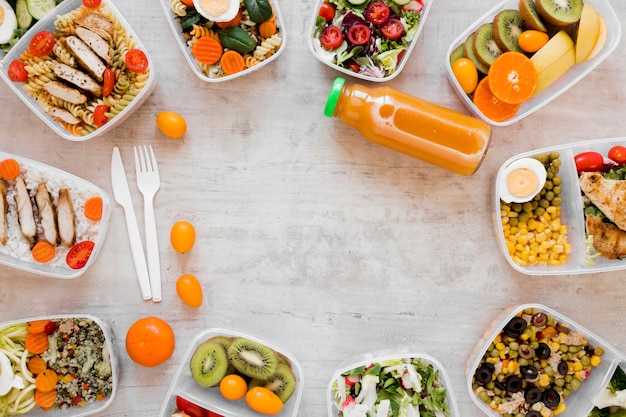Healthy Weekly Meal Plan with Grocery List
We’re trying something new this week! Giving you can ACTUAL plan that you can follow for 7 days- let us know what you think!
Medical Disclaimer: If you experience emotional eating, yo-yo dieting, or have a chronic illness, always consult your doctor before changing your diet.
Have you ever thought of meal planning, but you’re not sure where to start or it sounds too complicated? Luckily, a healthy weekly meal plan doesn’t have to be complicated. Plus, there are several benefits of meal planning weekly besides healthy eating. There are no rules to meal planning so you can’t mess it up. You just need to set aside a little time each week to make a grocery list and do a little planning. It can do wonders for both your schedule and your health! Let’s dive in.

Top benefits of meal planning.
- Save money
- Eat healthy
- Lose weight
- Save time
- Have more family time
Sitting down to planned family meals will not only save you money, time and effort, but it will improve your health as well.
When it comes to feeding yourself or raising a family, one of the hardest jobs is trying to come up with solutions for dinner every night, let alone trying to find the time to cook!
Yet the single most important thing you can do for you and your family’s health is to cook and eat at home! Keep reading to get a healthy weekly meal plan with a grocery list.
Related read: Monthly Meal Planning Ideas: How to Create a Monthly Meal Planner

Home cooked meals contain.
- Less Salt
- Less Sugar
- Fewer Calories
- More Nutrients
- Less Preservatives
- Less Chemicals
- No Artificial Dyes
- Less Packaging
Cooking at home gives you control over the quality of your family’s food. By planning out meals, you can balance out nutrient-dense foods throughout the week giving your family the healthiest food choices for growing minds and bodies.
This can be a huge game changer since it’s been found that restaurant foods are usually packed with unnecessary preservatives and additives.
Meal planning can be enjoyable and you will find that it becomes easier and easier with a little practice. Planning ahead for the upcoming week is going to make you feel accomplished and organized.
Top ten benefits of planning family meals.
- Kids of all ages need and love family rituals. Kids also thrive on daily routines. In this hectic world that we live in, sitting down to a family meal at 6:00 every night is stable and familiar.
- Eating family meals together provides children with a well-needed sense of security and belonging.
- Much, much better nutrition! Any meal cooked at home is pretty much guaranteed to be healthier than eating fast food or take-out.
- According to experts, a family that eats together regularly is more likely to consume more fruits and vegetables and less fried foods and soft drinks.
- Children and teens are less likely to develop addictive habits such as drugs, alcohol or smoking.
- Children who feel important to their family are more likely to have a greater sense of self-confidence and are less likely to give into peer pressure.
- Saves money on groceries. Save tons of money and time when you shop with a grocery list. Sticking to a plan can help you save money and time each month by reducing random buying and countless trips to the grocery store. Want a better dinner hour? Have a better plan!
- Parents can control what ingredients go into home-cooked foods. Salt is becoming a nightmare as high sodium levels are now being linked to high blood pressure in children from eating so much fast food.
- Children who eat meals together with their family have been found to do better academically.
- This is a great time to teach children communication skills. Lots of chatter at the dinner table and adult conversation gives kids an edge with verbal communication skills.
Keep reading to get a healthy weekly meal plan with a grocery list.

7-day meal plan.
Each day should bring a balance a flavors. A big game changer for our health has been trying to get in at least one salad a day and lunch always seems to be the best time do sneak one in for us! The serving size for most of these items is on the small side, so adjust as needed! You should feel satiated and not constantly hungry with your meals.
Sunday.
Breakfast: Whole-wheat toast with salsa-scrambled eggs.
Lunch: Salad greens mixed with 3 ounces tuna, 1/4 cup herbed brown rice, 1 tablespoon of olive oil, and 2 tablespoons all-purpose vinaigrette
Dinner: Roman-style roast chicken with roasted vegetables and herbed brown rice (Reserve 6 thighs, 3 cups brown rice, and 3 1/2 cups roasted vegetables for later in the week.)
Monday.
Breakfast: Oatmeal with raisins and butter
Lunch: Salad greens mixed with 1/2 cup rinsed and drained chickpeas, 1 tablespoon of olive oil, and 1 tablespoon all-purpose vinaigrette, stuffed into a toasted whole-wheat pita
Dinner: Roast vegetable frittata: Chop 1/2 cup leftover roasted vegetables and stir into 2 beaten eggs. Pour into a small nonstick skillet and bake at 350 degrees until set, about 12 minutes.
Tuesday.
Breakfast: Whole-wheat toast with 1/8 avocado and 2 ounces smoked salmon
Lunch: Salad greens mixed with 1/2 cup chopped leftover chicken, 1 tablespoon grated Parmesan cheese, 1 tablespoon of olive oil, and 1 tablespoon all-purpose vinaigrette
Dinner: Roast vegetable quesadilla: Chop 1/2 cup leftover roasted vegetables, and toss with 1 ounce shredded low-fat cheddar. Place between 2 tortillas and cook in a skillet over medium heat until lightly brown on both sides. Serve with 1/8 mashed avocado and salsa.
Wednesday.
Breakfast: Morning burrito: Scrambled eggs with salsa and 1/8 avocado wrapped in a whole-wheat tortilla
Lunch: Hummus and pita: Puree 1/2 cup rinsed and drained chickpeas with 1 teaspoon olive oil, 1 small clove garlic, and juice of 1/2 lemon.
Dinner: Italian chicken soup: Stir 1 crushed clove garlic, 1/2 cup diced leftover chicken, 1/2 cup leftover roasted vegetables, and 1/4 cup leftover brown rice into 2 cups low-sodium chicken broth. Heat over medium-low heat until steaming, about 5 minutes.
Thursday.
Breakfast: Oatmeal with raisins and butter
Lunch: Salad greens mixed with 1/4 cup rinsed and drained chickpeas, 1 tablespoon olive oil, and 1 tablespoon all-purpose vinaigrette stuffed into a warm whole-wheat pita
Dinner: Chicken with tomatoes and olives: In a sauté pan, combine 1 teaspoon olive oil, 4 chopped black olives, and 1 anchovy fillet. Add 1/4 cup tomato sauce and 1 leftover chicken thigh, and cook until hot. Top with chopped parsley.
Friday.
Breakfast: Whole-wheat toast with salsa-scrambled eggs
Lunch: Toss 1/4 cup rinsed and drained chickpeas, 1/8 diced avocado, 1 tablespoon of olive oil and 1 tablespoon all-purpose vinaigrette, and serve over salad greens.
Dinner: Brown rice and roasted vegetable casserole: Combine 1 cup leftover roasted vegetables, 1 cup leftover brown rice, 1 egg, and 1/4 cup parsley in an oven-safe skillet. Top with 2 tablespoons shredded whole-fat cheddar. Bake at 350 degrees until warmed through and cheese is melted, about 8 to 10 minutes. Reserve half for lunch tomorrow, and eat half with salad greens tossed with 1 tablespoon all-purpose vinaigrette.
Saturday.
Breakfast: Whole-wheat toast with 1/8 avocado and 2 ounces smoked salmon
Lunch: Leftover brown rice and roasted vegetable casserole
Dinner: Pita pizza: Spilt 1 pita, and spread a thin layer of tomato sauce over each half. Top with leftover roasted vegetables, chopped olives, and 2 tablespoons grated Parmesan cheese. Broil until pizza is hot and cheese is browned, about 2 minutes.
Snacks.
This is at the bottom of the meal plan because it’s optional depending on your metabolism and habits. If you find your energy waning or you feel rabid in between meals, it’s great to have some healthy snacks on hand that will fuel your body. I am personally a mid-morning and afternoon snacker. Without these, I end up starving and eating everything in sight when I get a chance (not the best habit). You can also add these to your meals if you feel you need a little extra too. Here are some options:
- Nuts or seeds- almonds, walnuts, pecans, cashews, pumpkin seeds, or sunflower seeds (NOT peanuts)
- Smoothies- (here is one of my favs!)
- A piece of fruit or vegetable- our go to’s are bananas, apples, carrots, and cucumber
- Plain yogurt with fruit or whole-fat kefir
The beauty of this meal plan
Did you notice how freaking simple this plan is? You literally do one big batch of booking on Sunday and then you can quickly whisk together the rest of the week’s meals. Some are repetitive (which is okay) yet there is enough of a mix for the week that you shouldn’t feel bored.

Grocery List.
1 bunch parsley
1 head broccoli
1 head cauliflower
2 (10-ounce) bags salad greens
1 sweet potato
1 avocado
1 lemon
1 head garlic
100% whole-wheat sandwich bread (if you can find organic and sprouted, even better!)
Whole-wheat pitas
1 pack 6-inch whole-wheat tortillas
Natural almond butter
1 tin anchovies (optional)
1 jar black olives
Fennel seeds
Red pepper flakes
1 dozen eggs
1 small 6 oz. cup of plain full fat yogurt
1 wedge aged Parmesan cheese
Full-fat cheddar cheese
8 boneless, skinless chicken thighs (about 2 pounds)
1 pouch (4 ounces) smoked salmon
Pantry Items
Long-grain brown rice
Rolled oats
1 can (3 ounces) low-mercury tuna
1 can (15 ounces) no-salt added chickpeas
Low-sodium chicken broth
No-salt added tomato sauce
Salsa
Raisins
Dijon mustard
Extra-virgin olive oil
White wine vinegar
Cooking spray
Salt
Pepper
Sugar
Don’t forget to add in any staples for the snacks we discussed above!
***Note: This meal plan and shopping list were made based on ONE person. For a partner or family members, add as needed to your list! You will find some items you don’t need extra of- like olive oil, salt, pepper, and parsley.
Pairing healthy eating with healthy habits.
Eating a well-balanced diet can help you get the calories and nutrients you need to fuel your daily activities, including regular exercise.
When it comes to eating foods to fuel your exercise performance, it’s not as simple as choosing vegetables over doughnuts. You need to eat the right types of food at the right times of the day.
Eating a balanced diet and being physically active are two of the most important things you can do to be and stay healthy at any age.

The importance of a healthy lifestyle.
It’s not just a balanced diet that’s enough but also healthy practices of eating. Some of them which you can follow are:
Eat-in smaller portions – As Americans we tend to overeat. You can do this by eating in small bowls to trick your brain into thinking it to be larger portions. (Note- if you are a chronic yo-yo dieter do not follow this one, you probably need to eat more!)
Take time to eat – Not rushing your meals in between other work but taking the time to nourish your meals can send signals to your brain that you’ve had enough food necessary for functioning.
Cut down on snacks – Unhealthy snacks are a strict no as they hamper your hunger. Switching to healthy bite-sized food can help.
Curb emotional eating – Binge eating can be extremely harmful. Using it to relieve yourself from stress, sadness, or anxiety may affect your health. Instead, you can use healthier alternatives to beat negative emotions like a mindfulness routine.
There you have it, a full week of meal planning that you can start today!
I have personally always struggled with sticking to a plan and a grocery list. But when I manage to do so, it is magical!
What about you? Do you love meal planning and making a grocery list? Do you like to cook at home? I’d love to hear!







